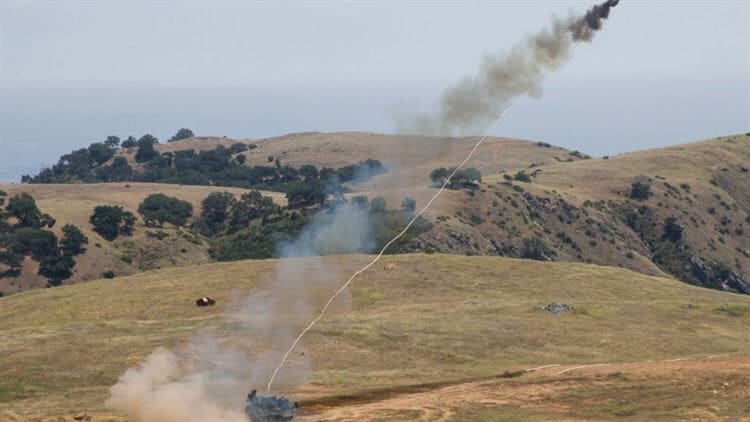By Kaitlin Kelly, MCSC Office of Public Affairs and Communication | Marine Corps Systems Command
MARINE CORPS BASE QUANTICO, Va. — Assault Amphibian Battalions across the Marine Corps are beginning to receive an upgraded mine clearance capability following a series of improvements to make it safer and more efficient to operate.
Known as the MK-154 Mine Clearance System, it is the only amphibious vehicle breaching capability in the Department of Defense that can penetrate coastal defenses with explosive obstacle breaching on land or water.
“The MK-154 was deadlined four years ago after the loss of a Marine ?during a training event,” said Robert Davies, a Safety official with Marine Corps Systems Command. “While certainly the last four years have been spent making the system more reliable and driving down the cost of maintenance, the big driver for the past four years was to ensure that we put out a system that was vastly safer.”

U.S. Marines with 3rd Assault Amphibian Battalion, 1st Marine Division, fire a MK-154 Launcher Mine Clearance on Camp Pendleton, Calif., June 23, 2017. Marine Corps Systems Command has reengineered the MK-154 with a new hydraulic and electrical system that makes the capability safer, more reliable and cheaper to maintain. (US Marine Corps photo by LCpl Maritza Vela)
Since then, the MK-154 has been reengineered with a new hydraulic and electrical system that makes the capability safer, more reliable and cheaper to maintain.
The upgraded MK-154 Mod 1 includes a self-bleeding hydraulic system and a test system that lets operators know it is safe to fire, according to Capt. Anthony Molnar, project officer for the MK-154/MK-155 at MCSC.
“Before the enhancements, it was difficult to employ the MK-154 due to intrusion of air into the hydraulic system. Air intrusion into the hydraulic system would render it inoperable,” said Molnar, who is also a combat engineer officer.
AAV crewman would have to conduct a lengthy “bleeding” of the hydraulic system in order to push the air out and operate the system. The legacy system also had expensive custom parts and some of the subsystems were antiquated. The legacy MK-154 was fielded in the early 1980s and has been in service in the Marine Corps over 30 years.
“With the upgraded hydraulic system, the MK-154 can operate with air in the hydraulic lines and self-bleed any air out during operation of the system,” said Molnar. “This makes the new system more reliable and reduces time needed to prepare for missions.”
Another new feature is the addition of a capacitor bank to the power distribution box. When the MK-154 is turned on, a crewman will use the AAV power to charge these capacitors. Once charged, the capacitors are used as a backup power source. This makes the new system safer for Marines because it can be fired using the backup power source if the AAV loses power, Molnar said.
Additionally, a new test box and test firing system were added to test the firing circuits of the electric system. The test box and test system are used to simulate live ordnance when plugged into the electric system. Prior to loading live ordnance, AAV crewman plug in the test system and cycle through the firing sequences as if live ordnance were loaded. During this test, the test box will verify that the MK-154 firing circuitry is safe by the illumination of green lights. If there is a fault in the firing circuitry, the test box will indicate a fault with a red light.
“The benefit of this new test box and system is that if there is a misfire during the actual employment of the demolition charges, the AAV crewman knows there is an issue with the ordnance and not the MK-154,” said Molnar. “This allows them to troubleshoot faster and safely complete their missions.”
The test box will fire circuits of the rockets and the linear demolition charges through this system. Marines then cycle through the firing sequence of all the rockets and line charges through the test box, verifying that there are no faults in the firing circuitry.
In all, 47 systems are being fielded across the Corps, primarily to Assault Amphibian Battalions. Fielding is expected to be completed by the end of fiscal year 2018.
“This piece of equipment is giving the [Marine Air-Ground Task Force] the ability to clear the way for amphibious landing on contested beaches,” said Molnar. “These upgrades provide increased efficiency and safety while also making Marines more lethal in combat.”


Really. What is the holdup? How many non military debutant’s have to take their sweet ads time signing off on this. Silly. Just silly.
Clearly you do not know/understand anything about Acquisitions, product performance or safety tests that that are done to systems before it is fielded to the Warfighter.
I was observing the T&E of this system when a young Corporal had a misfire and burnt to death in the back of his Amtrack. Id’e assume with the significant amount of safety concerns involved with this as a result the employment timeline was pushed far right.